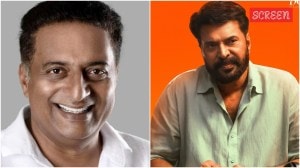Anonymity starring Richard Gere and Goldie Hawn
The subject was the star, the stars mere observers. But when talk centres on the Nature of Matter, the Nature of Life, and the presiding dei...

The subject was the star, the stars mere observers. But when talk centres on the Nature of Matter, the Nature of Life, and the presiding deity is none other than His Holiness the Dalai Lama, the celeb quotient does cease to exist.
So Hollywood heart-throbs Richard Gere, dashing in an olive T-shirt, and Goldie Hawn, floating around in a sheer golden cape, occupied the humble position of mere observer.
So, too, did Dan Goleman, author of The Emotional Intelligence, while Nobel laureate physicist Steven Chu and Eric Lander, a leading genome expert, were pegged a rung higher as participants here today.
A gathering with enough star power to generate mass hysteria elsewhere but here at McLeodganj, where life flowed at its placid pace. No heads turned when Gere and Goldie decided to walk to the Chonor guesthouse, a good 10 minutes from the Dalai Lama’s residence, after the morning session on Day 3.
Only a group of urchins showed any interest, but their sights were trained on the Rs 500 notes Boston Russel, Hawn’s 19-year-old son, was distributing with the best karma.
Back in the office of the Dalai Lama, his man Friday, the Venerable Lhakdor, tried to put things into perspective. ‘‘It’s the dialogue that should be your focus, not the people.’’ Adam Engle, the brains behind the US-based organisers Mind and Life Institute, nodded vigorously. So did Gere, every bit as good-looking in real life in the reel.
Unhappiness, he said, was what had propelled him towards Buddhism aeons ago. But wasn’t he rich, handsome and super-successful, all that was required to be happy? ‘‘You know better’’, he said, waving a hand. His goal is that of Everyman: to attain happiness and cultivate compassion.
Which is why he finds no difference between McLeodganj and Hollywood. ‘‘People are the same everywhere, with the same emotions.’’
Yes, he admitted, Dharamshala could do with a clean sweep. Two years ago, his foundation tried to do it, but to no avail. ‘‘I thought things would change, we would have one-way road, covered sewers, but nothing has changed, nothing except the DC, health officer…’’
Which is when you realise that Gere isn’t your ordinary tourist, he knows the town’s babudom inside out. Also the people. Hence, the knowledge that they alone could help themselves. ‘‘I don’t have that kind of time’’, he shrugged, trotting back to the conference hall.
Goleman had a few moments, just enough to tell you that the last such dialogue in March 2000 gave him the staple for his book Destructive Emotions, due for release next January. It also gave an impetus to research on meditation at Harvard, which proved that people who meditate have much higher positive emotions than the normal.
Goldie Hawn, who’d taken a short break for tea, vouched for it. A self-confessed Indophile — ‘‘I feel happy, and at home here’’ — she called meditation her daily fix. ‘‘It helps me marshal my mind, choose the right from wrong, become a more compassionate person.’’
Later, sitting in the tankha-covered room, soaking in the sage dialogue, you realise it’s this C-word that binds these scientists, actors and monks together. Chu, a professor of physics at Stanford and a believer in no religion with a name, put it into words when he said: ‘‘All of us agree with the Dalai Lama’s belief that we should develop compassion for the world around us, for doing good is good for us as well.’’
But it was His Holiness who had the last word: No action, he declared, was good or bad, it’s the motivation that counts. Using that as the yardstick, the gathering, with the monks on the one hand and the scientists on the other, discovered that there was really no dichotomy between science and religion. None at all, if both were used for the human good. That is the bottom line.



- 01
- 02
- 03
- 04
- 05




























